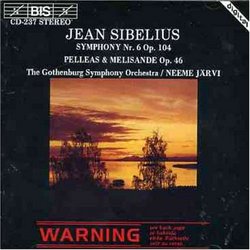| All Artists: Jean Sibelius, Neeme Järvi, Gothenburg Symphony Orchestra Title: Sibelius: Symphony No. 6; Pelleas & Melisande Members Wishing: 0 Total Copies: 0 Label: Bis Original Release Date: 1/1/1984 Re-Release Date: 4/19/1993 Album Type: Import Genre: Classical Styles: Forms & Genres, Theatrical, Incidental & Program Music, Historical Periods, Modern, 20th, & 21st Century, Symphonies Number of Discs: 1 SwapaCD Credits: 1 UPC: 750582007927 |
Search - Jean Sibelius, Neeme Järvi, Gothenburg Symphony Orchestra :: Sibelius: Symphony No. 6; Pelleas & Melisande
 | Jean Sibelius, Neeme Järvi, Gothenburg Symphony Orchestra Sibelius: Symphony No. 6; Pelleas & Melisande Genre: Classical
|
Larger Image |
CD DetailsSimilar CDs |
CD ReviewsExcellent Sibelius performance Philly Gal | Philadelphia, PA USA | 11/26/2008 (5 out of 5 stars) "This Gothenburg Symphony Orchestra interpretation of the Sibelius No. 6 is a sparkling delivery of a strings and woodwinds symphony. This D-minor symphony was composed during World War I and it strongly reflects the growing conflict. One doesn't have to strain the imagination to arrive at this conclusion. It opens with a magic pastoral vision of undisturbed nature, perhaps a forest during the last warm, calm days of summer. The strings maintain a rhythmic, lively foundation while the woodwinds increase in intensity and volume to complete the first movement - in the major key. The second movement moves away from this tranquility and perfect organization, alternating between major and minor tones, questioning, exposing growing instability. The tension increases until it ends loudly in the minor key. Now the third movement bursts open with marching (it cannot be described as anything else) and the woodwinds and horns drive with a steady mechanical tempo to a startling conclusion. In the last movement we have resolution, redemption, return to peace: it is almost a prayer of thanksgiving.
The second major recording on this CD is Sibelius's 1905 Suite from Pelleas and Melisande. This 9-movement version of his orchestral suite is an interpretation of the late 19th-century play by Maurice Maeterlinck. Here is the sad, timeless tale of illicit love between Pelleas and the married lady Melisande. She has not borne children to her husband Golaud, and when she becomes pregnant he grows suspicious and confronts Pelleas. It ends with the murder of Pelleas by her jealous husband Golaud, and the birth of a small, possibly malformed girl-child by Melisande. These 9 pieces are ripe for direct interpretation of this symbolic portrayal of the conflict between marriage & sterility, and love & revenge: by the end of the 4th movement, Melisande has lost her wedding ring in a spring, and the trap is set for her tragic ending. The 5th movement ("Melisande At The Spinning Wheel") is dark and heavy with the worrisome sound of her spinning wheel. The last movement is starkly short and to the point - all the time it takes for Golaud to beat his unfaithful wife and murder Pelleas. Oddly enough, despite the implied misery and violent outcome of this menage a trois, Sibelius did not create violent or startling music. Yet, his atmospheric suite subtly and fully reveals the tale when you know something of the story. Pelleas and Melisande is considered to be one of Sibelius's major works, although it has not received the same level of attention as Debussy's opera of the same title. The CD I have is an import produced by SKC Ltd. Korea under license from Grammofon Bis, Sweden. The sound is clear and full (labeled as a DDD mastering) - looks to be the same release as that in the Amazon listing photo." |

 Track Listings (13) - Disc #1
Track Listings (13) - Disc #1

